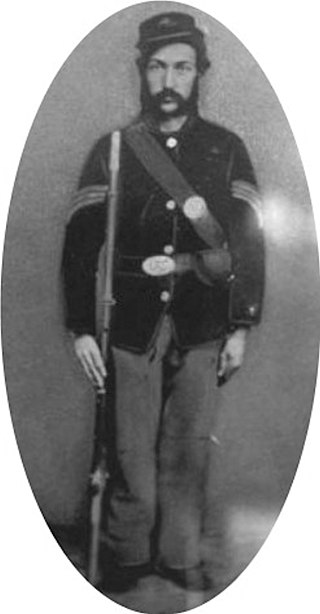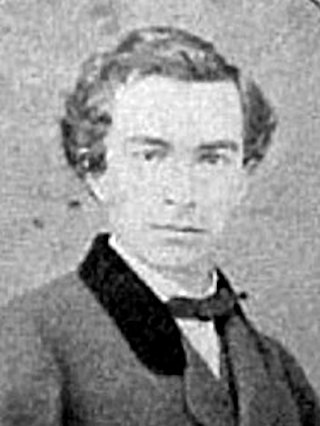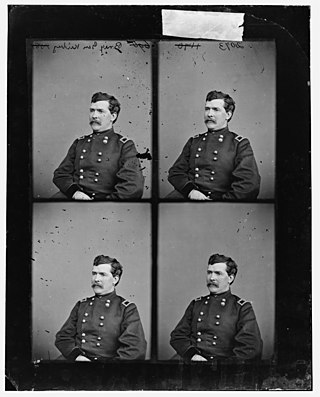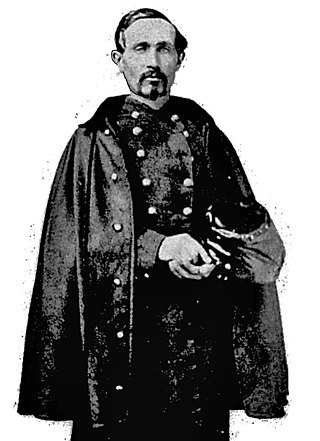
The Distinguished Service Cross (DSC) is the United States Army's second highest military decoration for soldiers who display extraordinary heroism in combat with an armed enemy force. Actions that merit the Distinguished Service Cross must be of such a high degree that they are above those required for all other U.S. combat decorations, but which do not meet the criteria for the Medal of Honor. The Army Distinguished Service Cross is equivalent to the Naval Services' Navy Cross, the Air and Space Forces' Air Force Cross, and the Coast Guard Cross. Prior to the creation of the Air Force Cross in 1960, airmen were awarded the Distinguished Service Cross.

Richard Enderlin was a musician and United States Army soldier who received a Medal of Honor for the heroism he displayed when fighting in the Battle of Gettysburg in 1863.
The 15th Indiana Infantry Regiment was an infantry regiment that served in the Union Army during the American Civil War.

Charles H. Seston was a Union Army soldier killed in action during the American Civil War. He posthumously received the Medal of Honor for gallantry during the Battle of Opequon more commonly called the Third Battle of Winchester, Virginia on September 19, 1864.

John T. Sterling was a Union Army soldier during the American Civil War. He received the Medal of Honor for gallantry during the Battle of Opequon more commonly called the Third Battle of Winchester, Virginia on September 19, 1864.

James R. Durham was a Union Army officer during the American Civil War. He received the Medal of Honor for gallantry during the Second Battle of Winchester, Virginia on June 14, 1863.

Thomas McCoy Wells was an Irish born Union Army soldier and officer during the American Civil War. He received the Medal of Honor for gallantry during the Battle of Cedar Creek fought near Middletown, Virginia on October 19, 1864. The battle was the decisive engagement of Major General Philip Sheridan's Valley Campaigns of 1864 and was the largest battle fought in the Shenandoah Valley.

Charles Henry Ilgenfritz was a Union Army soldier in the American Civil War who received the U.S. military's highest decoration, the Medal of Honor.

Edward M. Knox was a Union Army soldier in the American Civil War who received the U.S. military's highest decoration, the Medal of Honor.

Joseph C. Hibson was a Union Army soldier in the American Civil War who received the U.S. military's highest decoration, the Medal of Honor.
Lemuel F. Holland was a Union Army soldier in the American Civil War who received the U.S. military's highest decoration, the Medal of Honor.

Robert A. Gray was a Union Army soldier in the American Civil War who received the U.S. military's highest decoration, the Medal of Honor.

Joseph Olds Gregg was a Union Army soldier in the American Civil War who received the U.S. military's highest decoration, the Medal of Honor.
Theodore W. Greig was a Union Army soldier in the American Civil War who received the U.S. military's highest decoration, the Medal of Honor.

Francis Bloodgood Hall was a Union Army soldier in the American Civil War who received the U.S. military's highest decoration, the Medal of Honor.

William T. Holmes was a Union Army soldier in the American Civil War who received the U.S. military's highest decoration, the Medal of Honor.

Dennis Thomas Kirby was a Union Army soldier in the American Civil War who received the U.S. military's highest decoration, the Medal of Honor.
Jonathan C. Kirk was a Union Army soldier in the American Civil War who received the U.S. military's highest decoration, the Medal of Honor.
Benjamin W. Schenck was a Union Army soldier in the American Civil War who received the U.S. military's highest decoration, the Medal of Honor.

Ruel Milton Johnson was an American soldier who fought in the American Civil War. Johnson received the Medal of Honor, his country's highest award for bravery in combat, for his extraordinary heroism at the Battle of Missionary Ridge on November 25, 1863, while a major in temporary command of the 100th Regiment, Indiana Volunteer Infantry. He was honored with the award on August 24, 1896. Johnson was later promoted to lieutenant colonel, and commanded the 100th Indiana from May 2, 1865, until it was mustered out on June 8, 1865. After the Civil War, Johnson worked as a lawyer, and died in 1901 in Goshen, Indiana.













